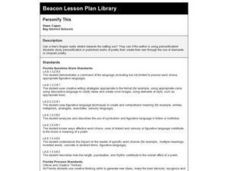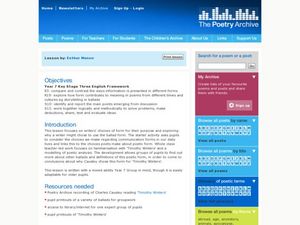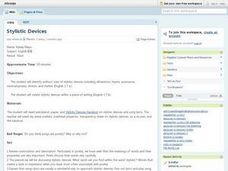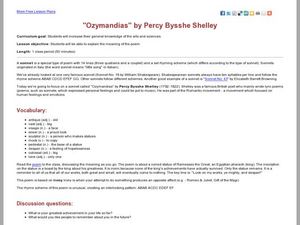Curated OER
Let's Learn Library Language
This PowerPoint presentation provides a review of 'library language', vocabulary associated with books and the library such as cover, title, author, illustrator, call number and fiction/nonfiction. Each slide of this PowerPoint displays...
Curated OER
Forms Of Knowledge
Students put writing pieces into categories to show different organizational features in writing. In this writing lesson plan, students are shown examples of speeches, poems, editorials, cartoons, parodies, historical fiction, and more.
Curated OER
Poetry IV--Similes and Metaphors
Students solve and write riddles using similes and metaphors. In this similes and metaphors lesson, students work in groups to solve descriptive riddles for famous landmarks. Students are given pictures of landforms and write...
Curated OER
Poetry: What's on Your Plate (Part 2)
Students write a short paragraph using strong descriptions. In this using modifiers lesson, students define modifier, adjective, adverb, metaphor, and simile. Students then write a journal entry in which they write about a...
Utah Education Network (UEN)
Self-Concept: Self-Esteem
Most teenagers struggle with self-image and self-esteem. Guide them through these stormy waters with a series of activities focused on positive messages, true friendship and support, and self-concept.
Curated OER
Cliches, Paradoxes
Clichés, paradoxes, and equivocations are detailed in a short, animated video that defines and illustrates these writing traps. The resource also includes a quiz and the transcript for the video. Users can register to access free course...
Facing History and Ourselves
Confirmation and Other Biases
As the investigation into the reporting of the events in Ferguson, Missouri, continues, class members consider how bias influences perception, how the tendency is to collect evidence that supports preconceived notions. The big idea...
Curated OER
Figurative Language
Young scholars interpret figurative language. In this language lesson, students are read the poem "I Love the Look of Words" by Maya Angelou and are to find examples of hyperbole and personification in the poem. Young...
Curated OER
Personify This
Eighth graders study personification in published works of poetry, then create their own through the use of diamante or cinquain poetry. They read and discuss poetry by Shel Silverstein, William Jay Smith, and Elinor Wylie.
Curated OER
Limericks
Fourth graders look up the definition of "Limerick" in the dictionary. They listen to the teacher explain a limerick and read an example of a limerick. Students brainstorm rhyming words and write their own limericks.
Curated OER
A Moment in Time
Eighth graders study poems to see how punctuation, line length, rhythm and word choice can be used to create a memorable moment. They read and discuss poems by Shel Silverstein.
Curated OER
Similes, Metaphors, and Symbols
Here is an outline of a lesson in which learners examine the use of similes, metaphors, and symbols in poetry. They define similes, metaphors, and symbols, complete a handout, and create a poem using types of figurative language.
Curated OER
Ballads and Communication
Students compare and contrast different forms of communication. For this poetry lesson, students focus on the ballad form and read "Timothy Winters". Students draw conclusions from the ballad and divide into groups to research the...
Curated OER
Understanding Character
Learners are introduced to literary elements and definitions in the worksheet Understanding Character but reading through each of the elements and definitions aloud. They read the story, "La Bamba" and identify examples of the literary...
Pennsylvania Department of Education
Comparing Key Ideas and Details in Fiction and Nonfiction
Students recognize the differences between fiction and nonfiction texts. In this genre study lesson, students discuss what nonfiction means and write the definition. Students listen to a read aloud and vote whether the text is fiction or...
Curated OER
Emotion Similes
Students define what a simile is before writing a poem that is based primarily on similes. They brainstorm and write the poem using the give format. They write drafts, revise and present a final poem.
Curated OER
Blank Verse and Iambic Pentameter
Shakespeare's use of language is the focus of this short PowerPoint. Each of the three slides describes one way he chose to write his plays: in iambic pentameter, and in couplets. The final slide describes a sonnet, which is a lyric poem...
Curated OER
Looking for Newton
Students discuss the rhyming pattern of various types of poetry. With a focus on limericks, they follow the specific rhyme scheme and create a limerick about Newton. They share their poem with the class and write another one related to...
Curated OER
The Odyssey Lesson 6
"How are belief systems represented and reproduced through nature?" This essential question guides lesson 6 of this unit on The Odyssey (the rest of the unit is linked). Students first write about a scenario in which they are...
Curated OER
Buggy Patterns
First graders discuss the definition of patterns, and sing the song, Going Buggy, identifying patterns in the song. They create original patterns using bug counters and insect stickers.
Curated OER
Language Arts: Creative Writing Devices
Eighth graders review sound and rhythm devices and apply them to their own writing exercises. Next, they interpret the poem, "Where I'm From," as an example of a personal narrative. Using their understanding of poetic devices, they...
Curated OER
God's Weaving in Taylor's "Huswifery"
Eleventh graders trace Taylor's use of conceit or extended metaphor in his poem "Huswifery" where he compares the process of cloth making to God's salvation of man, and write a poem in which they compare a personal transformation with an...
Curated OER
Stylistic Devices
Students review connotation and denotation and stylistic devices in poetry. They read the lyrics to a song as it is being played and then discuss the meaning of the song. As a class, students read poems, share their thoughts, and...
Curated OER
"Ozymandias" by Percy Bysshe Shelley
Learners complete reading and vocabulary activities for Percy Bysshe Shelley's "Ozymandias." In this literary analysis lesson, students review vocabulary and related definitions for the text. Learners read the poem and discuss the meaning.

























